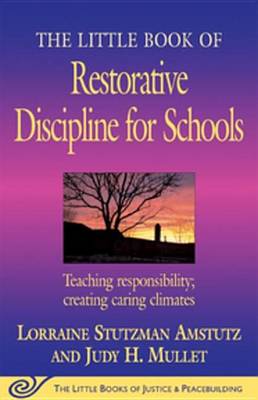Justice and Peacebuilding
3 total works
The Little Book of Restorative Discipline for Schools
by Lorraine Stutzman Amstutz
Published 1 January 2015
Can community-building begin in a classroom? The authors of this book believe that by applying restorative justice at school, we can build a healthier and more just society. With practical applications and models.
Can an overworked teacher possibly turn an unruly incident with students into an "opportunity for learning, growth, and community-building"? If restorative justice has been able to salvage lives within the world of criminal behavior, why shouldn't its principles be applied in school classrooms and cafeterias? And if our children learn restorative practices early and daily, won't we be building a healthier, more just society?
Two educators answer yes, yes, and yes in this new addition to The Little Books of Justice and Peacebuilding series. Amstutz and Mullet offer applications and models. "Discipline that restores is a process to make things as right as possible." This Little Book shows how to get there.
Can an overworked teacher possibly turn an unruly incident with students into an "opportunity for learning, growth, and community-building"? If restorative justice has been able to salvage lives within the world of criminal behavior, why shouldn't its principles be applied in school classrooms and cafeterias? And if our children learn restorative practices early and daily, won't we be building a healthier, more just society?
Two educators answer yes, yes, and yes in this new addition to The Little Books of Justice and Peacebuilding series. Amstutz and Mullet offer applications and models. "Discipline that restores is a process to make things as right as possible." This Little Book shows how to get there.
The Little Book of Restorative Justice for Sexual Abuse
by Judah Oudshoorn, Lorraine Stutzman Amstutz, and Michelle Jackett
Published 12 November 2015
Here is a thoughtful and thought-provoking look at the impact of sexual abuse demonstrating how restorative justice can create hope through trauma.
Restorative justice is gaining acceptance for addressing harm and crime. Interventions have been developed for a wide range of wrongdoing. This book considers the use of restorative justice in response to sexual abuse. Rather than a blueprint or detailing a specific set of programs, it is more about mapping possibilities. It allows people to carefully consider its use in responding to violent crimes such as sexual abuse.
Criminal justice approaches tend to sideline and re-traumatize victims, and punish offenders to the detriment of accountability. Alternatively, restorative justice centers on healing for victims, while holding offenders meaningfully accountable. Criminal justice responses tend to individualize the problem, and catch marginalized communities, such as ethnic minorities, within its net. Restorative justice recognizes that sexual abuse is a form of gender-based violence. The table of contents includes:
Community-based practices are needed, sometimes in conjunction with, and sometimes to counteract, traditional criminal justice responses.
Restorative justice is gaining acceptance for addressing harm and crime. Interventions have been developed for a wide range of wrongdoing. This book considers the use of restorative justice in response to sexual abuse. Rather than a blueprint or detailing a specific set of programs, it is more about mapping possibilities. It allows people to carefully consider its use in responding to violent crimes such as sexual abuse.
Criminal justice approaches tend to sideline and re-traumatize victims, and punish offenders to the detriment of accountability. Alternatively, restorative justice centers on healing for victims, while holding offenders meaningfully accountable. Criminal justice responses tend to individualize the problem, and catch marginalized communities, such as ethnic minorities, within its net. Restorative justice recognizes that sexual abuse is a form of gender-based violence. The table of contents includes:
- Understanding Sexual Abuse
- Restorative Justice
- Victims: A Case Study
- Offenders: A Case Study
- Limits and Possibilities
- And much more!
Community-based practices are needed, sometimes in conjunction with, and sometimes to counteract, traditional criminal justice responses.
The Big Book of Restorative Justice
by Howard Zehr, Allan MacRae, Kay Pranis, and Lorraine Stutzman Amstutz
Published 15 February 2022
The four most popular restorative justice books in the Justice & Peacebuilding series-The Little Book of Restorative Justice: Revised and Updated, The Little Book of Victim Offender Conferencing, The Little Book of Family Group Conferences, and The Little Book of Circle Processes-in one affordable volume. And now with a new foreword from Howard Zehr, one of the founders of restorative justice!
Restorative justice, with its emphasis on identifying the justice needs of everyone involved in a crime, is a worldwide movement of growing influence that is helping victims and communities heal while holding criminals accountable for their actions. This is not a soft-on-crime, feel-good philosophy, but rather a concrete effort to bring justice and healing to everyone involved in a crime.
Circle processes draw from the Native American tradition of gathering in a circle to solve problems as a community.
Peacemaking circles are used in neighborhoods, in schools, in the workplace, and in social services to support victims of all kinds, resolve behavior problems, and create positive climates.
Each book is written by a scholar at the forefront of these movements, making this important reading for classrooms, community leaders, and anyone involved with conflict resolution.
Restorative justice, with its emphasis on identifying the justice needs of everyone involved in a crime, is a worldwide movement of growing influence that is helping victims and communities heal while holding criminals accountable for their actions. This is not a soft-on-crime, feel-good philosophy, but rather a concrete effort to bring justice and healing to everyone involved in a crime.
Circle processes draw from the Native American tradition of gathering in a circle to solve problems as a community.
Peacemaking circles are used in neighborhoods, in schools, in the workplace, and in social services to support victims of all kinds, resolve behavior problems, and create positive climates.
Each book is written by a scholar at the forefront of these movements, making this important reading for classrooms, community leaders, and anyone involved with conflict resolution.


